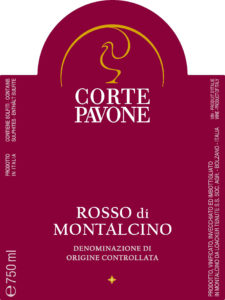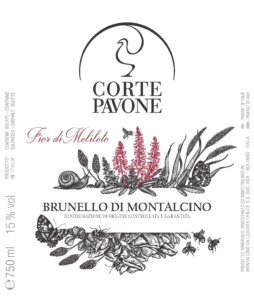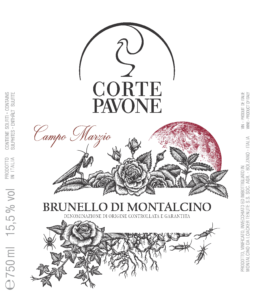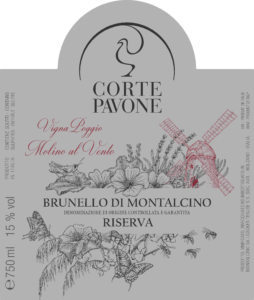
The Estate
Located in Tuscany, Corte Pavone extends for 16 hectares across the scenic Montalcino hillsides at an altitude of 500 meters, the vineyards surrounded by fields and thick Mediterranean scrub. This unique landscape and climate along with the light, clayey soil contribute greatly to the wine’s character.
The estate has belonged to the Loacker family since 1996, established by Rainer Loacker who for 20 years worked in the chocolate wafer business before making the plunge into the wine business. Rainer was an organic pioneer when he first started out, opting to use more natural treatments instead of pesticides on his vines. Gradually he made the transition to biodynamic farming. Today, Loacker only uses homeopathic treatments on their vines, and 3 years ago, a new bio-architectural cellar was constructed at the heart of the winery.
Franz Josef, Rainer’s son, oversees commercial aspects of the 4 Loacker vineyards (Schwarhof in Alto Adige, 2 in Tuscany, and 1 in Austria). His brother, Hayo, who trained in France, South Africa, and the US, manages the vines and wine making.
This winery is part of the Italian Organic Wine Route.

Rosso di Montalcino
Tasting Notes: Ruby red color. Ethereal notes of violet, forest floor, licorice, plum, spices, and tobacco. Medium-bodied with lively acidity and strong yet silky tannins. Pleasant, long finish. Dry and persistent.
Cellaring Potential: Drink from now to 2028.
Food Pairings: Pairs well with meat dishes, pecorino cheese, and plates served with fresh olive oil
Serving Temperature: 16-18°C
Region: Montalcino – Tuscany
Closure: Natural cork
Fun Fact: In 1984, this wine received the DOC classification due to its popularity with consumers. Over the years it has evolved into the “alter ego” of the Brunello.
First Vintage: 1998
Grape Varieties: Sangiovese Grosso
Classification: Rosso di Montalcino DOC
Average Age of the Vines: 16
Vinification: Spontaneous fermentation starts after the ‘pied-de-cuve’ is introduced and takes place in small stainless steel vats and in wooden, truncated, cone-shaped barrels with automated fullers. Macerations lasts 16 – 18 days. Extraction through delestage, pressing, and remontage.
Aging: Wood aging for 16 months, mostly in 30 hL barrels and in part in barriques. No fining, light filtration.
Altitude at Sea Level: 450-500 meters
Soil: Clayey soil rich in rock fragments, particularly marl
Vineyards and Year of Planting: Pian Ginestra (1984), Macchiese (1992), Fior Meliloto (1999), Campo Levante (2009 grafted)
Training System: Espalier with spur pruned

Brunello di Montalcino
Tasting Notes: Elegant aromas of dark chocolate, roasted meats, prunes, dried figs, ripe blackberries, and hints of truffle. On the palate, there is elegant acidity, silky tannins, discreet minerality, notes of ripe berries, and hints of mild spices. Good length. 100% vegan!
Cellaring Potential: Drink from 2018 to 2031
Food Pairings: Ideal with dark meet or matured cheeses like Pecorino
Serving Temperature: 17-18°C
Region: Montalcino – Tuscany
Closure: Natural cork
Background: The residents of Montalcino ‘ilcinesi” called the wine Bruno (brown) since the wine had an intense brownish color. Over the centuries, Bruno became Brunello.
First Vintage: 1990
Grape Varieties: 100% Sangiovese
Classification: Brunello di Montalcino DOCG
Average Age of the Vines: 15 years old
Vinification: Short maceration before fermentation at 8°C. Fermentation with indigenous yeasts in small stainless steel vats and in wooden truncated-cone shaped barrels with automated fullers; 30 days skin contact. Extraction through delestage, pressing and remontage.
Aging: During the first year, 30-40% in Tonneaux with 500-liter capacity, with the remaining quantity in large wooden barrels. 3 years oak aging in total. No filtration.
Altitude at Sea Level: 450-500
Soil: Clayey soil rich in rock fragments, particularly marl
Vineyards and Year of Planting: Anemone (1998), Mulino a Vento (1998), Campo Marzio (1967), Ramerino e Aromatica (1998)
Training System: Espalier with spur pruned

Brunello di Montalcino Fiore del Vento
Region: Montalcino – Tuscany
Altitude: 450-500 above sea level
Soil: Clayey soil rich in rock fragments, particularly marl
Training System: Espalier with spur pruned
Vineyards & Year of Planting: Anemone (1998)
Fun Fact: The residents of Montalcino ‘ilcinesi” called the wine Bruno (brown) since the wine had an intense brownish color. Over the centuries, Bruno became Brunello.
Grape Varieties: Sangiovese
Classification: Brunello di Montalcino DOCG
Average Age of the Vines: 20 years old
Yield: 4,000 kg/ha
Vinification: Short maceration before the fermentation at 8 degrees centigrades, fermentation with indigenous yeasts in small stainless-steel vats and in wooden truncated cone-shaped barrels with automated fullers and 30 days of skin contact. Extraction through delestage, pressing, and remontage.
Aging: During the first year, 30-40% in Tonneaux with 500 Lt. capacity and the remaining quantity in large wooden barrels. 3 years oak aging in total. No filtration.
Tasting Notes: Bright ruby red with garnet rim. The nose is very intense and rich–luscious aromas of blackberries, dark cherries, and plums, with a bit of cocoa in the background. Full and round at first taste; mid-palate it opens up, showing aromas of dark berries, intense fruit, and a lot of velvety tannins. Complex wine with long and full finish.
Cellaring: Drink from 2018 to 2037
Food Pairings: Ideal with dark meats or matured cheeses like Pecorino.
Serving Temperature: 15-17°C

Brunello di Montalcino Fior di Meliloto
Location: Italien, South Tyrol, Bozen & Umgebung
Lieu-Dit: Vigna Meliloto
Altitude: 450 – 500 m
Grape Varieties: 100% Sangiovese
Average Age of the Vines: 23 years old
Harvest: The grapes are handpicked and sorted, then placed into 15 kg casks.
Vinification: Partial malolactic fermentation. Spontaneous with Pied de Cuve. 100% mash fermentation for 1-16 days; complete destemming. Skin contact for 1-20 days. Fermentation – 5 days of pneumatic punching down and 18 days pumping over.
Aging: In small, 500 liter oak barrels for 1-12 months and 20,000 liter barrels for 1 month.
Certifications: Vegan, organic, La Renaissance des Appellations, bio-dynamic
Serving Temperature: 15 – 17 °C
Cellaring: 19-20 years
Optimum Drinking Years: 2020 – 2039
Tasting Notes: Dark ruby red color. Notes of dried fruit on the nose. Aromas of prune, sage, and light peppermint. Well-integrated wood with lovely, long-lasting aftertaste.

Brunello di Montalcino Campo Marzio
Location: Italien, South Tyrol, Bozen & Umgebung
Lieu-Dit: Vigna Campo Marzio
Altitude: 450 – 500 m
Grape Varieties: 100% Sangiovese
Average Age of the Vines: 50 years old
Harvest: The grapes are handpicked and sorted, then placed into 15 kg casks.
Vinification: Partial malolactic fermentation. Spontaneous with Pied de Cuve. 100% mash fermentation for 1-16 days; complete destemming. Skin contact for 1-20 days. Fermentation – 5 days of pneumatic punching down and 18 days pumping over.
Aging: In oak barrels for 1-36 months and steel tank for 1 month.
Certifications: Vegan, organic, La Renaissance des Appellations, bio-dynamic
Serving Temperature: 15 – 17 °C
Cellaring: 19-20 years
Optimum Drinking Years: 2020 – 2039
Tasting Notes: Ruby red color with aromas of morello cherry. The wine is structured and powerful on the palate, but with gentle tannins and a crisp acidity. Long, elegant aftertaste with notes of almond.

Brunello di Montalcino Vigna Poggio Molino Al Vento Riserva
Name: The name of the biggest cru vineyard “Molino al Vento” (meaning “windmill”) is a reference to the wind coming from the sea, which always rushes through the vines and most probably used to operate a windmill in this area.
Location: Italy, Toscana
Quality Grade: DOCG Brunello di Montalcino
Classification: Riserva
Sea Level: 450 – 500 m
Soil: Stony; galestro limestone slate
Harvest: Handpicked into 15 kg cask. Manual grape sorting.
Vinifcation: Fermentation is spontaneous with pied de cuve. Malolactic fermentation is carried out.
Aging: 1 month in 3000 L stainless steel tank; 36 months in 3000 L used oak barrels
Production: 3,600 bottles
Tasting Notes: Complex fruity nose. Good tannin, warm vintage noticeable, still very balanced on the palate. Long, complex finish.
Certificates: Vegan, organic, biodynamic
Allergens: Sulfites
Serving Temperature: 15-17 °C
Cellaring Potential: 20 years
Optimum Drinking Years: 2021 – 2040


